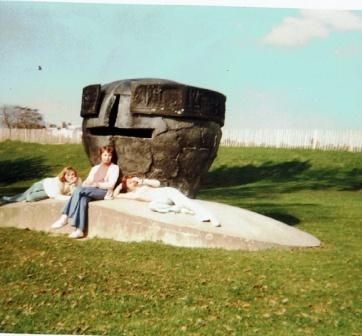As this was a suggestion of mine, inspired by a pic of me lolling by a sculpture on a school Geography trip almost 45 years ago, I’ve been asked to write a short resume of the meeting. It certainly was an animated evening!

My request was for us all to think about art in the public domain, from the post WW2 period, so something that is accessible to all that we could bring to everyone’s attention. I asked the following questions: is there a piece that we love or hate and does it enhance our lives, so would we miss it if it disappeared? Or, can you not wait to see the back of it and bring in the bulldozers?! Did we have something foisted upon us in the name of public art, or was it a good idea?
Public art isn’t always ‘modern art’, but very often can be and, I also widened the suggestions to perhaps include examples of architecture eg an outdoor facade or an atrium indoors, but still a public place. Statues, sculptures, murals, buildings; we have them all around us. I had originally just thought of British art, but we widened the scope and had some very interesting examples from elsewhere. This gave us some different angles on how others perceive art and its uses in the public space, for instance, propaganda.
Initially we discussed a sense of belonging and a sense of place. Can public art help us with this and enhance our lives? We felt that, generally, yes it can and therefore, is a good thing in that respect. Examples were given of the Angel of the North, the Poppies at the Tower of London and a future project, the Lancaster Bomber memorial to be erected on the A46 near Lincoln.
Not surprisingly, we focused on art in around Grantham, beginning with the 1.6 million given for the rejuvenation of Grantham market place and the installation of the Orrery. This was felt to be an example of how money had not been well spent to enhance the area! We also looked at art in the surrounding villages and thought that there were some commendable examples, such as murals, and at least the attempts were appreciated. However, the installation of an empty plinth and a gibbet left us somewhat bemused! The Moon installation that visited St Wulfram’s was described as beautiful and inspirational.
We discussed a Guardian article that suggested the six worst examples in Britain. These were the dead tree; the Scallop; the Manchester starburst; figures at Newbiggin; the Gloucester tower; footprint in North Wales. We concluded that whilst we agreed with some of them, several were good instances and, on the whole, we disagreed with the article.
Other examples we came up with included:
The statue at Dickie Lewis’s department store, Liverpool
Matthew Flinders’ statue, Euston station – the Lincolnshire ‘connection’!
Banksy and the merits of art against commercialism
The travelling exhibition of the knives sculpture
Treviso fountain, Italy
Antony Gormley – Angel of the North and his other works; message and meaning
Tucson, Arizona and the amazing murals on their buildings
Lewes, East Sussex, the Knights’ Helm – that school trip!
We didn’t come to any firm decisions as to which should stay and which should go, as we all felt differently about each one. The general opinion was that we would be worst off for not having Public Art, if only to have a good moan, which at least proves we’ve noticed it!
I was amazed at the amount of effort and research everyone had put in and I would like to thank you all for your time and contributions – some even from another Continent! I certainly think we achieved what I set out for lively minded women to do, have a very enthusiastic discussion!
Kay Ellerby
